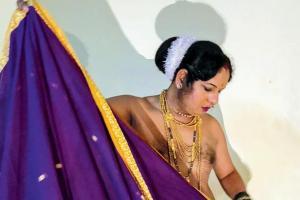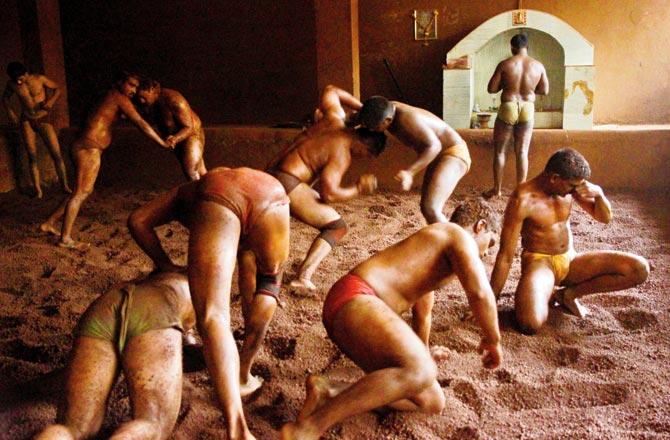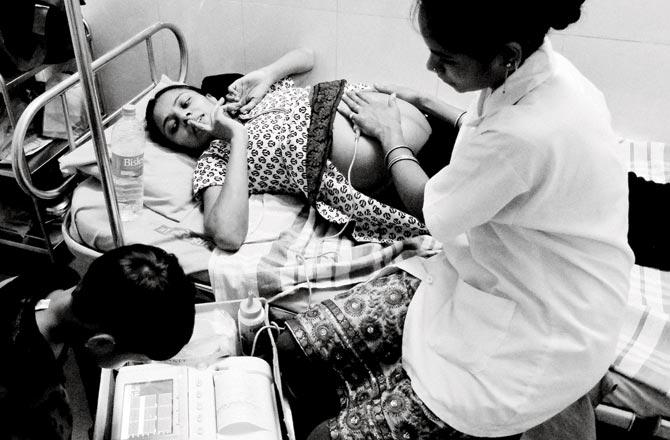Be it 35 days of hospitalisation of his pregnant wife or four months of observation of a fishing village, lensman Indrajit Khambe takes to his camera for memorialising personal and shared moments

Photographer Indrajit Khambe waits for a crucial 'saree' moment as Dashavtar artiste Omprakash Chavan crosses the gender divide
 Photographer Indrajit Khambe was stationed for 35 days at the Navare hospital, Kankavli (Sindhudurg district) besides his seven-month pregnant wife who underwent the transcervical amnioinfusion four years ago. But, as he attended to his wife and their five-year-old daughter, he was busy in another chore — moment-to-moment documentation of the would-be mother surrounded by her worried kin. At that point, it was his coping mechanism. Today, the 400 frozen moments titled Chasing the Question Mark are part of his family archive, of which 20 are accessible on his website and social media properties.
Photographer Indrajit Khambe was stationed for 35 days at the Navare hospital, Kankavli (Sindhudurg district) besides his seven-month pregnant wife who underwent the transcervical amnioinfusion four years ago. But, as he attended to his wife and their five-year-old daughter, he was busy in another chore — moment-to-moment documentation of the would-be mother surrounded by her worried kin. At that point, it was his coping mechanism. Today, the 400 frozen moments titled Chasing the Question Mark are part of his family archive, of which 20 are accessible on his website and social media properties.
These were selected as a print exhibit at the Ariano International Film Festival, Italy, as well as exhibited at the 2015 Indian Photography Festival (digital section) at Hyderabad. Ever since, his tryst with Hyderabad has continued — his fourth and latest photo series, Two Whistling Birds, selected this year. It depicts a month spent with his children, Saee, 8, and Sahir, 3, thriving in the green foliage of Kankavli. "I took a 'vacation' to document a childhood that is possible only in a small hill town with two lush rivers. It was the perfect setting to forget my frustration stemming from my crumbling computer repair business," declares Khambe, 37, who feels photography is the world's most fulfilling source of sustenance.

Wrestlers of Kolhapur arrested on Khambe's camera
Before Khambe goes to Hyderabad, he is Kolkata-bound for the July 15-22 Foundry Photojournalism Workshop scholarship he won for learning from 13 mentors like Ben Bohane, Ron Haviv, Maggie Steber and Prashant Panjiar. "Unless you seek great lensmen and women to evaluate your work, which fortunately is now possible in a super-connected world, you cannot transition to the next level in your craft," he observes. Khambe's photography rests on self-initiated tutorials, more so because he doesn't have formal training in camerawork. After his graduation from the Kankavli College, he dived into the computer repair-sales business, of course retaining other interests such as theatre.
As part of the Vasantrao Achrekar Pratishthan he acted as well as contributed backstage in 10-odd plays, like Mee Mazhyashi which was hosted by the National School of Drama in 2008. But neither computers nor theatre engaged him over the long term. In 2012, he gifted himself a Canon 7D and woke up to a freedom of movement that was foreign to him so far. As broadband internet came into his town, he started researching the photos that created history worldwide, appreciating the unique way in which the master photographers negotiated with the medium. If there was one frame that sealed his choice of photography as a full time occupation, it was Padmashree Sudharak Olwe's shot of a sewer worker. He was also influenced by some frames shot by Raghu Rai, Raghubir Singh, Sohrab Hura, Josef Koudelka, Garry Winogrand and Antoine d'Agata.

The lensman takes a picture of the horns of a cow - his latest muse
Khambe perfected his art while watching their work, just as he was enriched while assisting Pulitzer Prize winning Barbara Davidson when she visited Kolhapur's wrestlers for an assignment for Los Angeles Times. Khambe has a long-term academic interest in kushti which reflects in his print exhibition series Pehelwans Rising From The Soil; it was the reason for his support to Daniel Berehulak in his Kolhapur assignment for Panasonic Japan; also it recurred in his work for Channel News Asia's film on wrestling. Recently he got a grant from the open online resource platform Sahapedia (New Delhi) to document the world of red clay wrestling pits.
Subjects stay with Khambe and come to the fore at periodic intervals, much like the popular Dashavtar art form which was his obvious choice when he began camerawork. He grew up watching the dance ritual dramas held in temples, playgrounds and makeshift spaces, during festive occasions. He was enamoured by the gods, villains and heavenly maidens played by men. The cross-dressing, the make-up and the facial expressions of heavily dolled-up men featured in his initial frames. He found the work amateur in retrospect, but Dashavtar stayed with him and emerged in another series on his artist-friend Omprakash Chavan who has performed in more than 8,000 plays in the last 35 years.

Khambe takes a picture of his wife lying on the bed of a hospital for transcervical amnioinfusion
Khambe followed the actor in 30 villages, capturing the everyday life of a grassroots practitioner who had to put on the greasepaint even when his mother was seriously ill. In 2015, Chavan suffered a massive heart attack while performing on stage in one of the remote villages in Goa, a phase in which Khambe ceased to be just his photographer, but became his fund raiser who helped him settle the hospital bill. As Chavan's health bettered, Khambe joined him village-to-village. In 2017, People's Archive of Rural India (PARI) published Khambe's Dashavtar photo story, Chavan was integral to the theme. The classic frame in which a bare-chested Chavan adorns the saree is the one for which Khambe waited for five years: "the saree's border evokes the gender divide which folk artists transcend with consummate ease, an everyday act which can't be expressed in words!"
Khambe believes in complementing his documentation of social realities while working closely with groups and art practitioners who espouse similar engagement. "As a voice representing Konkan, Kankavli in particular, it's lovely to get a glimpse of how others perceive the human situation. What is photography without these conversations?" He was in Mumbai for an exchange hosted by Junoon Theatre at the MCubed Library last month, before which he spoke on his definition of art at St Xavier's College. In August, he will present his perspective in Baithak, the monthly interaction series conducted in the garage-turned-Kala Studio in Bandra! He was also shortlisted as one of the emerging photographers in the 2017-18 Fòcas Scotland platform.
Khambe feels photographers have to identify new audiences and record key moments in the public realm. "What's the point in the clichéd frames of Pushkar or Kumbh Mela or Vrindavan and some other exotica, when a hundred problems are staring you in the face?" He feels the cellphone camera has unimaginably democratised people's power to record events, trends and disputes.
"I don't justify the flippant exchange of photos on social media, but the cellphone click is a revolution. It is upon us as to how we capitalise the low-investment high-returns device to build communities." Since February this year, Khambe has been using his cellphone to document life in the Budhal fishing village (18 km from Guhagar) which he sees as an epitome of an untouched beach beauty. "Against the backdrop of polluted seashores, the death of traditional fishing and loss of livelihood, Budhal is a paradise that needs to be protected." Of late, the cow has also caught Khambe's fancy. Hailing from a Satara-based farmers' family which shifted to coastal Kankavli in the eighties, cattle and farms are very close to his heart. "Both are controversial and both need preservation," he moots a full-fledged photo show dedicated to livestock.
Sumedha Raikar-Mhatre is a culture columnist in search of the sub-text. You can reach her on sumedha.raikar@gmail.com
Catch up on all the latest Crime, National, International and Hatke news here. Also download the new mid-day Android and iOS apps to get latest updates
 Subscribe today by clicking the link and stay updated with the latest news!" Click here!
Subscribe today by clicking the link and stay updated with the latest news!" Click here!









